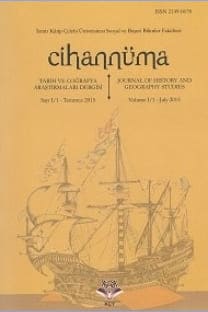Transkafkasya’da Güç ve Rekabet: XVII. Yüzyılın İlk Yarısında Güney Kafkasya’da Osmanlı-Safevi Mücadelesi
XVI. yüzyıl başlarından XVII. yüzyıl ortalarına kadar yaklaşık yüz elli yıl devam eden Osmanlı-Safevi mücadelesi başlıca iki coğrafyada cereyan etmiştir. Bunlardan biri Irak-ı Arap, diğeri Kafkasya'dır. Kafkasya tarih boyunca pek çok açıdan önem arzeden bir coğrafya olmuştur. Bu nedenle burası sürekli bir mücadele alanıydı. Nitekim Osmanlı ve Safevi devletleri de baştan itibaren bu coğrafyayı elinde tutmak istemiş, diğerine karşı burada üstünlük sağlamaya çalışmıştır. Bu makalede tarafların 1603'ten başlayarak XVII. Yüzyılın ilk yarısı boyunca Transkafkasya'daki mücadeleleri ve bu hususta geliştirdikleri politikalar, başta Gürcüler olmak üzere yerel unsurların bu mücadelelerdeki rolleri de göz önüne alınarak değerlendirilmiştir.
Anahtar Kelimeler:
Osmanlı Devleti, Safeviler, Transkafkasya, Gürcüler
Power and Competition in the Transcaucasia: The Ottoman-Safavid Competition in the South Caucasus on the Fırst Half of the Seventeenth Century
The Ottoman-Safavid conflicts from the early sixteenth to the mid-seventeenth century took place in two geographical spaces, namely Irak-i Arap (Iraq of the Arabs), and the Caucasus. Since the Caucasus is always a strategically important region from many perspectives, it was also a contested space between the Ottomans and Safavids. From the very beginning, Ottomans and Safavids were trying to control the Caucasus and constantly battling for the upper hand over the other. By focusing on the Ottoman-Safavid competition over the Transcaucasia in the period from 1603 to the mid-seventeenth century, this article examines the politics of these two empires in this competition with a special emphasis on the role of local actors in this conflict, particularly the maneuvers of Georgian groups.
- ISSN: 2149-0678
- Yayın Aralığı: Yılda 2 Sayı
- Başlangıç: 2015
- Yayıncı: İzmir Katip Çelebi Üniversitesi
Sayıdaki Diğer Makaleler
Özer Küpeli, Osmanlı-Safevi Münasebetleri (1612-1639)
Yerşekillerinin Kırsal Yerleşim Dokusu Üzerindeki Etkilerine Bir Örnek Olarak Tire İlçesi Köyleri
Osmanlı Döneminde Mora’da Bir Sahil Şehri: Balya Badra/Patra (1460-1715)
Kriz ve Savaş Arasında 1641 Tarihli Venedik Ahidnâmesi
Cahit Telci, İzmir ve Yöresi Tarihinin Kaynakları: Halil Beğ Defteri (1425-1430)
Aydın Sancağı’nın En Erken Tahrir Defteri: Halil Beğ Defteri’nin Parçası
Mısır’a Uygulanan Haçlı Ekonomik Ambargosu Karşısında Çerkes Memlûkleri
